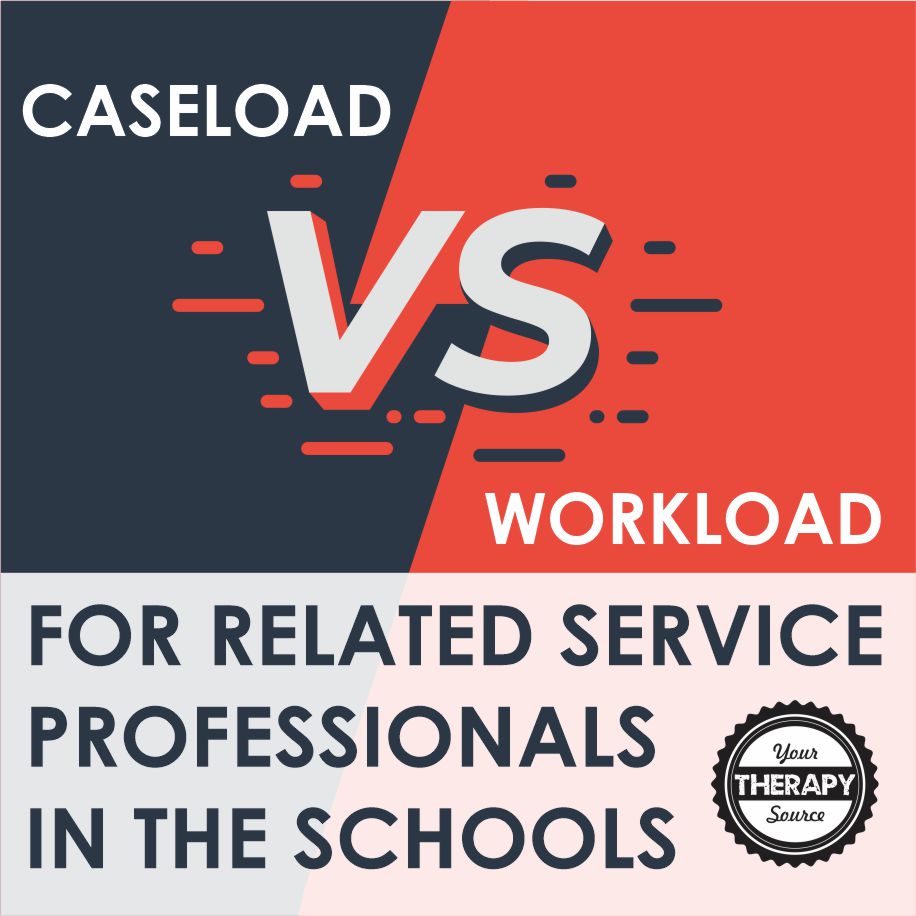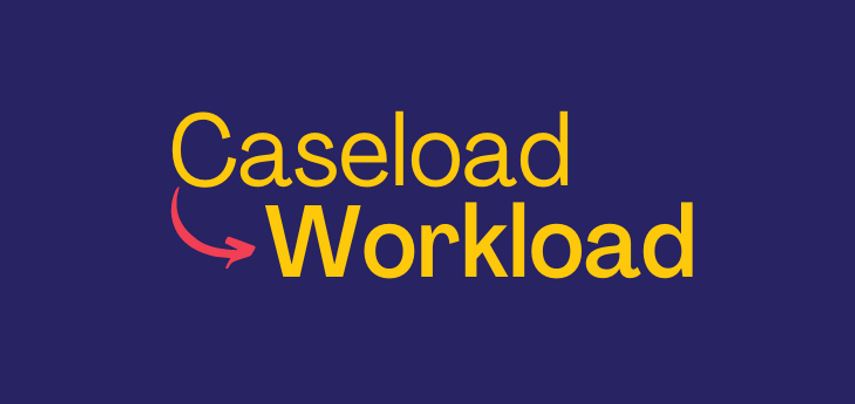Caseload Versus Workload for Related Service Professionals
Are you familiar with the terms caseload versus workload in the school setting for related service professionals? Many school districts are moving towards a workload model to try and support their students.

WHAT DOES CASELOAD MEAN?
Caseload method means that there is a specific number of students that each staff member will work with based Individualized Education Programs (IEPs), Individualized Family Service Plans (IFSPs), and 504 Plans. It is not based on how much time it takes to meet each student’s needs or other duties of the professionals. Staff will also have other responsibilities in the school.
Caseloads can be measured by the number of intervention sessions an OT, PT, or SLP has available during a given time period. Caseloads based on a medical model don’t capture the range of service demands placed on these professionals in school settings.
WHAT DOES WORKLOAD MEAN?
Workload refers to all the activities that need to be done by related service professionals. This includes all of the duties assigned to OTs, PTs, and SLPs. These duties could be: direct interventions, group sessions, consultations, meetings, and/or documentation.
Your workload as a related service professional is based on the requirements of your educational setting. It includes assessment and interventions, as well as working with regular and special education staff, communicating with parents, and participating in school and district-level committees.
CASELOAD VERSUS WORKLOAD?
The workload approach looks at how the therapist’s time is spent. It looks at how much time the therapist spends with different students doing different tasks to help that student reach their goals. That may mean direct service, consulting with a parent, assistive technology, equipment repair, etc.
A caseload approach looks only at the number of students who need services or the number of intervention sessions that are needed.
The American Occupational Therapy Association, American Physical Therapy Association, and the American Speech-Language-Hearing Association states that “given the increasing roles, responsibilities, and demands on OTs, PTs, and SLPs in school-based practice settings, a workload approach seems most likely to ensure compliance with IDEA 2004 requirements and state and local mandates.”
HOW TO IMPLEMENT A WORKLOAD MODEL
There are multiple steps to start a workload model in your school district.
Step One
Individual related service professionals can do a workload analysis by looking at all the work-related activities and bundling them into categories that show the different roles and responsibilities (including documentation and administration duties). Take a close look at whether your district could support a 3:1 model.
A 3:1 model is when the related service professionals provide direct services for 3 weeks and the fourth week allows time for indirect services to collaborate with others to evaluate student progress and complete other responsibilities that help students learn.
Try This Calculator
Try using this calculator that was designed for school-based OT/OTAs to determine your weekly workload. Want to get more serious and have more guidance? Check out this full course below (this is an affiliate link)
Sign Up for a Course
Earn 4 hours of professional development and harness the knowledge and tools you need to show your administrators the valuable benefits of moving from a caseload model to a workload approach.
That includes developing a picture of your workload based on your current caseload, completing and analyzing a two-week time study, and drafting a document to share with your administrators.
Here are the exact objectives we will cover in the Making the Shift Casload to Workload Course:
1. Identify how a caseload model differs from a workload model.
2. Recall research related to occupational therapy and using a workload approach.
3. Appraise your current caseload and workload and distinguish how it is impacting your practice.
4. Create a plan for moving to a workload approach and maintaining it.
Who is this course for?
This course is designed for School-based OT practitioners and other related service providers who are looking to help their school(s) move toward an effective workload approach in order to save time and provide more ethical and effective therapy.
This is an intermediate-level course and is for therapists who feel they could be successful in the schools if they had just a little more time and a bit of administrative support. No prerequisites are required.
◆ FIND OUT MORE INFORMATION ABOUT THE MAKING THE SHIFT: CASELOAD TO WORKLOAD COURSE HERE.◆
Step Two
Work together at the district and local levels, and perform a workload analysis overall. Collaborate to collect data on workload demands for OT, PT, Speech, and counseling professionals to take a look at the bigger picture throughout the district.
Meet with your administration to discuss the information that you have collected to try to make the change from a caseload to a workload model.
Step Three
Talk with your national and state-wide professional organizations to identify caseload issues and promote workload-based systems and policies to improve the delivery of related services for students.
Read more about the steps to take here.
CASELOAD VERSUS WORKLOAD – WHAT DOES THE RESEARCH SAY?
There is evidence that shows that a workload approach to service delivery is the best way to provide effective and productive interventions in a school setting. However, more research was needed on how service delivery works in the United States.
A recent survey conducted online with 371 school-based practitioners indicated the following results:
- practitioners wanted to move their practice to a workload model but cited lack of administrative support, time, procedural knowledge, and decreased advocacy skills as barriers to implementation.
- regardless of the research that indicates best practice, occupational therapy practitioners continue to provide services outside of the classroom and other natural settings (Seruya and Garfinkel, 2020).
CONCLUSION
If you’ve been struggling to manage your caseload, it might be time for a change. There are different models of service delivery professionals use when working with students in school districts.
One such model is the workload model; this strategy can help educators take cases while allowing enough time to provide quality care to each student they work with. Have you tried any of these strategies?
REFERENCES
American Occupational Therapy Association, American Physical Therapy Association, American Speech-Language-Hearing Association. Workload Approach: A Paradigm Shift for Positive Impact on Student Outcomes. Retrieved from the web on 2/6/22 at https://www.aota.org/-/media/corporate/files/practice/children/apta-asha-aota-joint-doc-workload-approach-schools-2014.pdf.
Seruya, F. M., & Garfinkel, M. (2020). Caseload and workload: Current trends in school-based practice across the United States. The American Journal of Occupational Therapy, 74(5), 7405205090p1-7405205090p8.



